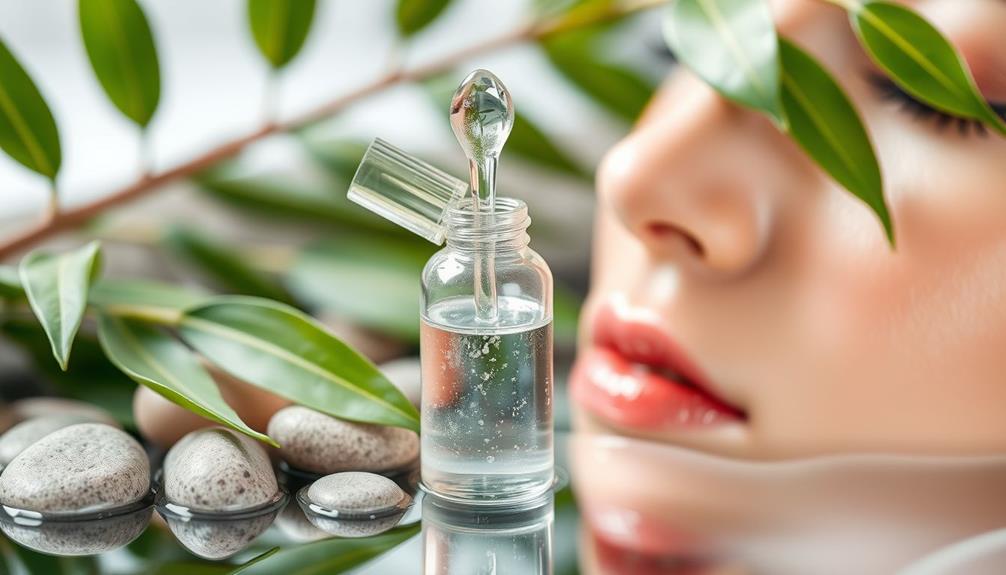Glycolic acid is your secret weapon for clear skin, loved by dermatologists everywhere. This powerful exfoliant helps reduce acne lesions, unclogs pores, and improves your skin's texture by sloughing off dead cells. Start with a low concentration (5-10%) a few times a week at night to assess tolerance. Don't forget to pair it with a good moisturizer to keep your skin hydrated. You can even explore professional peels for more dramatic results if needed. Ready to reveal a fresh complexion? Keep exploring to discover how to maximize the benefits of glycolic acid in your skincare routine. Some of the key benefits of glycolic acid for skin include its ability to improve skin tone, reduce the appearance of fine lines and wrinkles, and promote collagen production for a more youthful look. By incorporating glycolic acid into your skincare routine, you can also address pigmentation issues and achieve a smoother, more radiant complexion. Remember to always wear sunscreen during the day when using glycolic acid, as it can increase your skin’s sensitivity to the sun. With consistent use, you’ll soon be enjoying the many benefits of glycolic acid for your skin.
Key Takeaways
- Glycolic acid is a potent exfoliant that unclogs pores and promotes cell turnover for clearer skin.
- It effectively reduces acne lesions and diminishes hyperpigmentation from UV exposure and past breakouts.
- Starting with lower concentrations (5-10%) is recommended to assess skin tolerance before increasing frequency.
- Combining glycolic acid with moisturizers containing ceramides helps maintain hydration and supports the skin barrier.
Glycolic Acid Explained
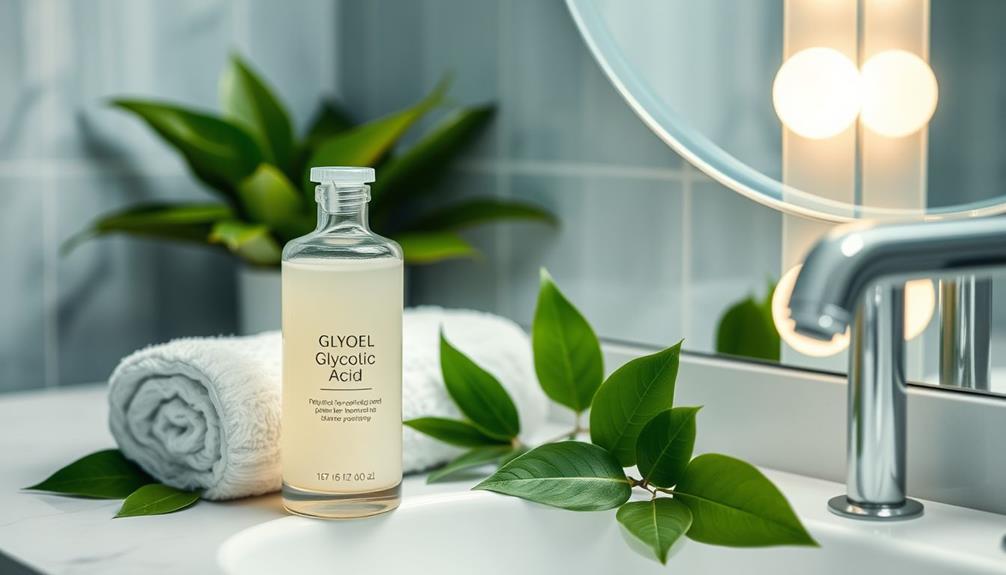
Glycolic acid is a powerful exfoliant from sugarcane that effectively breaks down dead skin cells, revealing a clearer and smoother complexion. As an alpha hydroxy acid (AHA), it works by dissolving the bonds that hold dead skin cells together, allowing you to easily exfoliate the skin. This process not only improves skin texture but also helps in acne treatment by reducing acne lesions and preventing future breakouts.
Additionally, incorporating essential oils into your skincare routine can enhance the overall therapeutic effects on your skin, providing a holistic approach to skincare.
Incorporating glycolic acid into your skincare routine can stimulate collagen production, which is crucial for maintaining youthful skin and minimizing fine lines. With its small molecular structure, glycolic acid penetrates the skin more effectively than other AHAs, making it particularly beneficial for surface-level skin concerns.
You can find glycolic acid in various formulations, including serums, creams, and chemical peels, with concentrations ranging from 5% to 30%. This versatility allows you to choose a product that suits your skin type and sensitivity.
Benefits for Acne and Hyperpigmentation

Many people find that incorporating glycolic acid into their skincare routine leads to significant improvements in both acne and hyperpigmentation. This powerful ingredient works by promoting cell turnover, which helps to unclog pores and reduce acne lesions effectively.
Additionally, essential oils like peppermint oil may provide cooling relief to the skin, complementing the effects of glycolic acid. As you regularly use glycolic acid, you may notice fewer breakouts and a clearer complexion.
Glycolic acid excels at addressing hyperpigmentation. By sloughing off dead skin cells and excess melanin, it helps diminish the appearance of dark spots from UV exposure or past acne scars. The result is a more even skin tone and improved skin texture, making it a must-have for anyone struggling with these issues.
Dermatologists often recommend using glycolic acid concentrations of 5-10% for sensitive skin to avoid exacerbating hyperpigmentation. Incorporating this ingredient into your routine not only tackles active acne but also addresses the remnants it leaves behind.
With consistent use, you can achieve smoother, clearer skin and enjoy the confidence that comes with it. Glycolic acid truly is a game-changer for those seeking to improve their skin's appearance.
How to Use Glycolic Acid
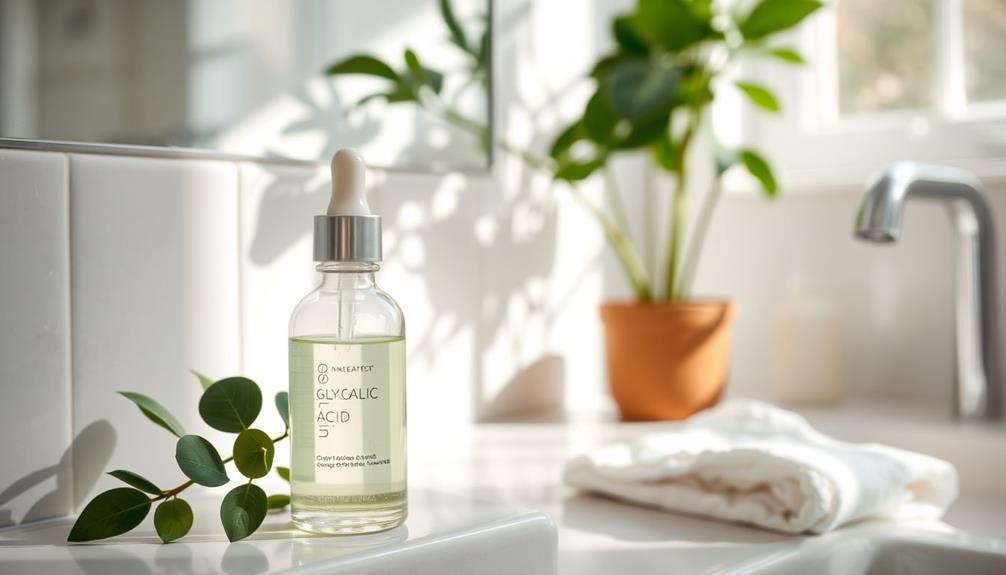
To effectively incorporate glycolic acid into your skincare routine, start with a lower concentration, applying it just a few times a week to assess your skin's tolerance. This initial approach helps minimize irritation, especially if you have sensitive skin.
Begin with a product containing 5-10% glycolic acid, and apply it to cleansed skin ideally at night. This timing takes advantage of its exfoliation properties while reducing sun sensitivity. Additionally, consider pairing glycolic acid with other nourishing ingredients, such as butter's nutritional benefits, to enhance skin hydration and overall health.
As your skin builds tolerance, gradually increase the frequency of use, but keep an eye out for any signs of irritation or adverse reactions.
After applying glycolic acid, follow up with a moisturizer that contains ceramides to maintain hydration and support your skin barrier. This step is essential, as glycolic acid can lead to dryness.
Combining With Other Ingredients
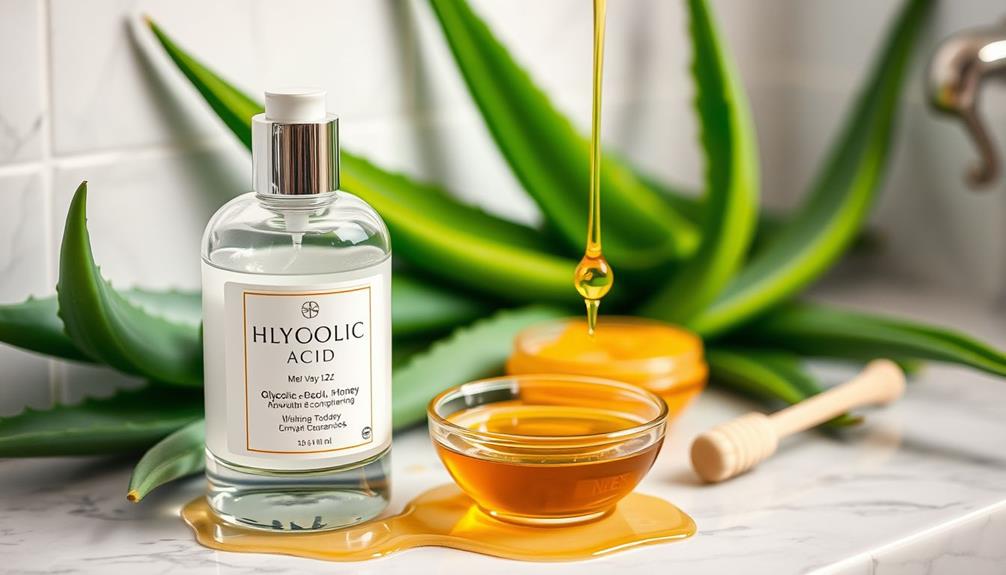
When combining glycolic acid with other ingredients, it's essential to know what works well together and what doesn't.
You should avoid pairing it with other AHAs or BHAs to prevent irritation.
Instead, consider safe options like lactic acid or vitamin C, which can enhance your skincare routine without compromising your skin's health.
Safe Ingredient Combinations
Combining glycolic acid with certain ingredients can enhance your skincare routine while minimizing the risk of irritation. For instance, pairing glycolic acid with lactic acid can elevate exfoliation benefits without causing significant skin sensitivity. This combination allows you to enjoy smoother, clearer skin while maintaining comfort.
However, it's important to avoid using retinol alongside glycolic acid. This duo can lead to increased irritation and skin sensitivity, which isn't ideal for your routine. Instead, consider using a moisturizer containing ceramides after applying glycolic acid. This will help soothe your skin and support the skin barrier, ensuring your complexion stays balanced and hydrated.
Vitamin C is another great option when using glycolic acid, but keep in mind that applying them at different times of the day is best. This strategy maximizes their benefits while minimizing irritation.
Always consult with a dermatologist if you're unsure about your combinations or how your skin might react. By carefully selecting your ingredients, you can create a powerful, effective skincare routine that promotes clear, glowing skin without compromising your comfort.
Avoiding Potential Irritation
Avoid mixing glycolic acid with other AHAs or BHAs, as this can lead to increased irritation and sensitivity in your skin.
It's especially important to avoid combining glycolic acid with retinol, since both are potent active ingredients that can exacerbate irritation.
If you have sensitive skin, start with lower concentrations of glycolic acid, typically between 5-10%. This approach allows your skin to acclimate gradually, minimizing potential irritation.
Incorporating a good moisturizer into your routine is vital. Look for products that contain ceramides, as they help soothe your skin and support the skin barrier, which is essential when using exfoliating acids.
Always monitor your skin responses when applying glycolic acid; if you notice any signs of irritation, consider adjusting the frequency of use.
You may want to limit applications to a few times a week, especially in the beginning.
Professional Treatments and Peels

If you're considering professional glycolic acid treatments, you're in for some impressive benefits.
These peels can help tackle severe acne and improve your skin's overall texture more effectively than at-home options.
Let's explore how to choose the right treatment for your skin needs.
Benefits of Professional Peels
Professional glycolic acid peels offer powerful exfoliation and skin renewal, making them an effective solution for various skin concerns.
These professional peels contain higher concentrations of glycolic acid (30-70%) compared to over-the-counter products, guaranteeing more pronounced results. They specifically target issues like hyperpigmentation, acne lesions, and signs of aging, which can lead to improved skin texture and tone.
Regular treatments under dermatologist supervision greatly boost collagen production, enhancing skin firmness while reducing the appearance of fine lines and wrinkles.
Clinical studies have shown that glycolic acid peels effectively decrease acne severity and lesions, making them an invaluable option for anyone struggling with persistent breakouts.
Additionally, these professional peels not only provide rapid results but also guarantee a safer application tailored to your skin type, minimizing potential irritation.
By investing in glycolic acid peels, you're taking a proactive step toward achieving clear skin and addressing your specific skin concerns.
With ongoing commitment, the benefits of these treatments can lead to a smoother, more radiant complexion that you'll be excited to show off.
Choosing the Right Treatment
Selecting the right glycolic acid treatment involves understanding your unique skin concerns and working closely with a skincare professional to determine the best concentration and frequency for your needs.
Professional glycolic acid peels typically use higher concentrations (30-70%) than over-the-counter products, making them more effective for significant skin renewal.
When considering glycolic acid peels, think about your skin type and specific concerns, such as acne scars or hyperpigmentation. A skincare professional can help you identify the ideal concentration tailored to your skin's needs.
Initial treatment often requires a series of sessions spaced several weeks apart to achieve the best results and guarantee your skin tolerates the treatment well.
Research highlights that glycolic acid peels can effectively reduce sebum production and improve skin texture, especially for individuals with acne vulgaris.
By consulting a skincare professional, you'll not only receive guidance on the right peel concentration but also how frequently to schedule treatments for ongoing texture improvement.
With their expertise, you're more likely to achieve your desired skin goals safely and effectively.
Recommended Products for Skincare
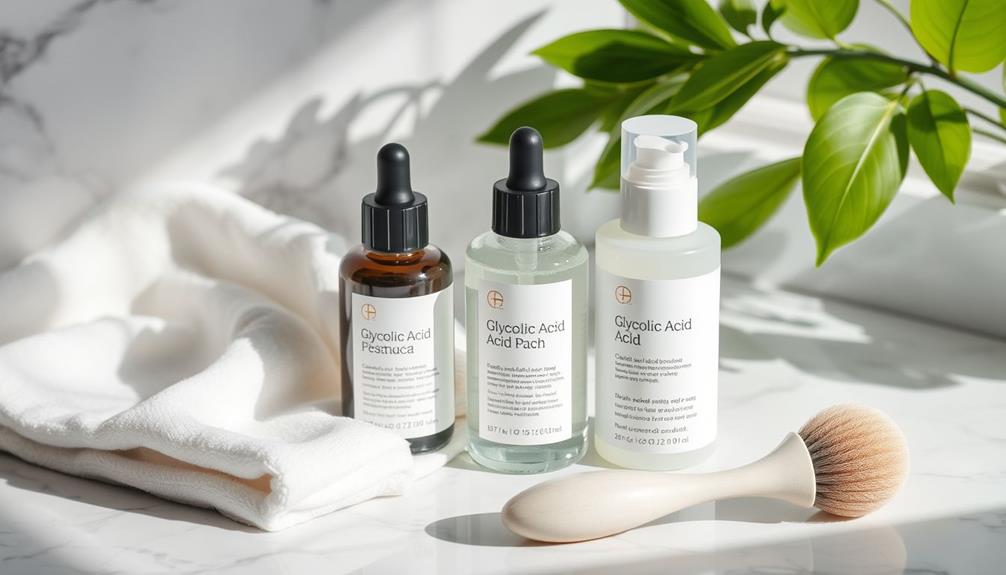
For achieving clear skin, incorporating specific glycolic acid products into your skincare routine can make a significant difference.
Start with a glycolic acid cleanser, like the Dermatologists Choice Glycolic Peel Cleansing Pads. These pads help clear pores and improve skin texture with consistent use.
After cleansing, consider a mild glycolic acid cream, such as the Facial Enhancement Cream, which is perfect for post-bump phase care, maintaining skin hydration and promoting renewal.
Next, enhance your routine with the Intensive Redensifying Glycolic Acid Day Moisturiser. This product not only boosts skin moisture retention but also provides essential anti-aging benefits.
To tackle specific signs of aging, don't miss the Anti-Ageing Glycolic Lifting Face & Neck Mask, which utilizes glycolic acid's exfoliating properties for a more youthful complexion.
Frequently Asked Questions
Do Dermatologists Recommend Glycolic Acid?
Yes, dermatologists recommend glycolic acid for its exfoliating properties. It helps unclog pores and reduce breakouts. Just start with a lower concentration to see how your skin reacts, and follow a good skincare routine.
Does Glycolic Acid Make Your Skin Clear?
Ever wonder how some people achieve that radiant glow? Glycolic acid can indeed make your skin clear by exfoliating dead cells, unclogging pores, and promoting even tone, giving you the fresh complexion you desire.
What Does Glycolic Acid Do to the Face?
Glycolic acid exfoliates your skin by removing dead cells, revealing a smoother surface. It boosts cell turnover, reduces fine lines and uneven tone, unclogs pores, and enhances moisture retention for healthier, radiant skin.
Is Vitamin C or Glycolic Acid Better for Wrinkles?
When it comes to wrinkles, think of glycolic acid as a sculptor chiseling away imperfections, while Vitamin C acts like a shield against damage. Choose based on your skin's needs—exfoliation or protection.
Conclusion
So, there you have it! Glycolic acid can be your skin's best friend, helping you achieve that clear, glowing complexion you've always wanted.
Just think of it as the modern-day elixir for your skin woes, as if Cleopatra herself endorsed it!
With the right application and a bit of patience, you'll see fantastic results.
Remember to pair it with other quality ingredients and consult with your dermatologist for the best outcomes.
Your skin will thank you!
